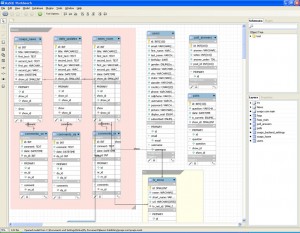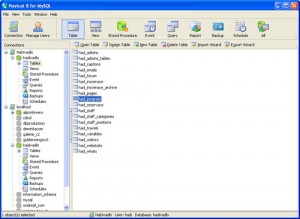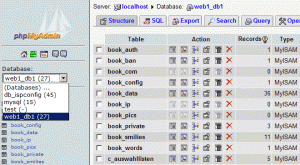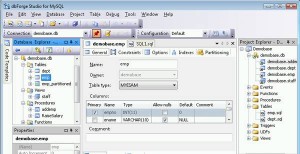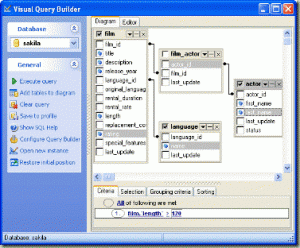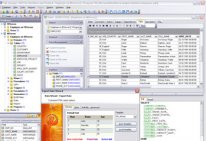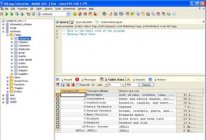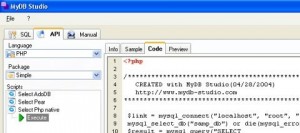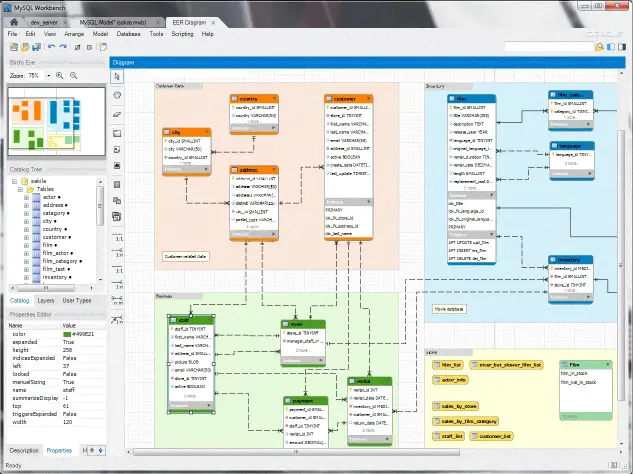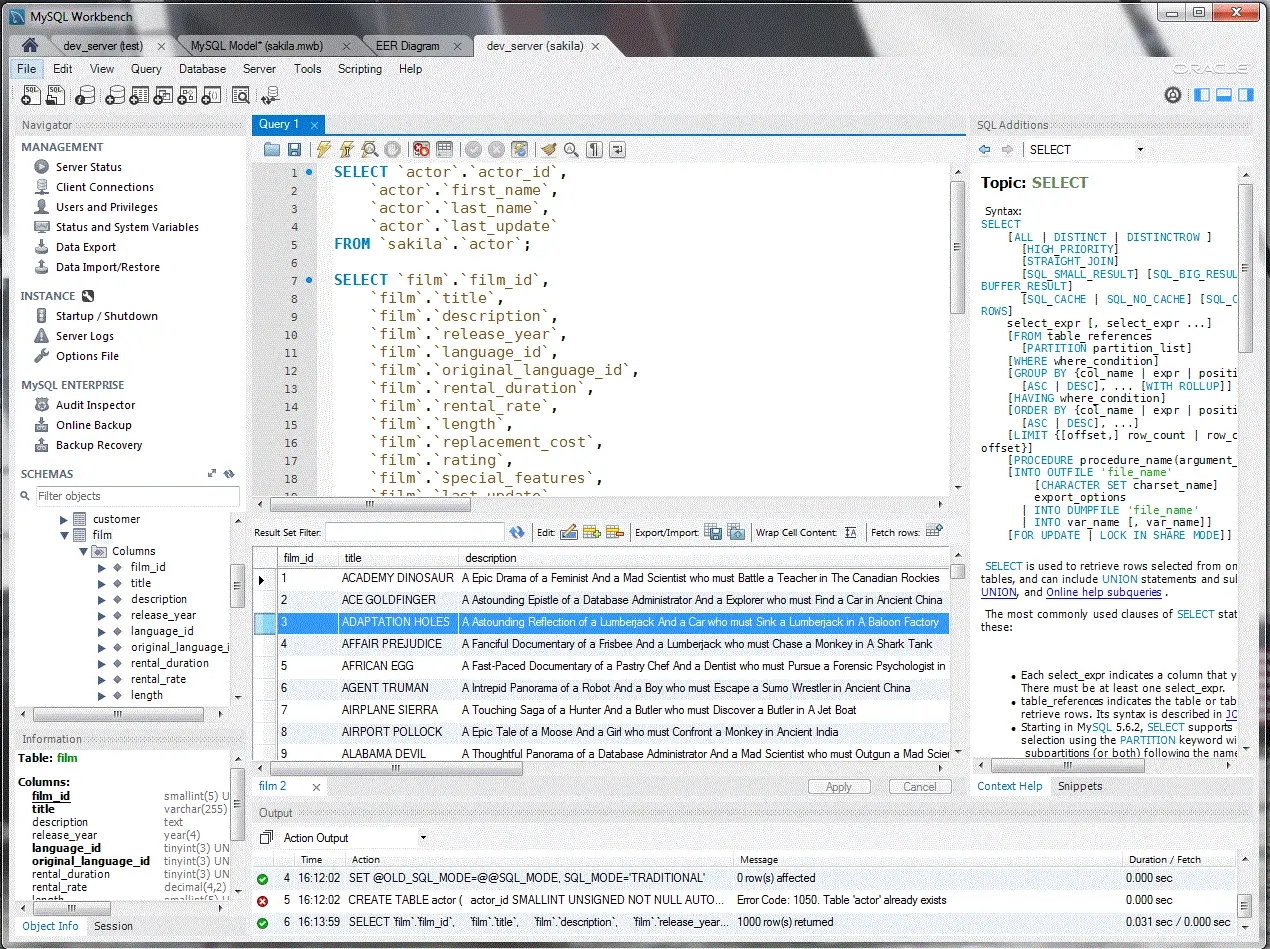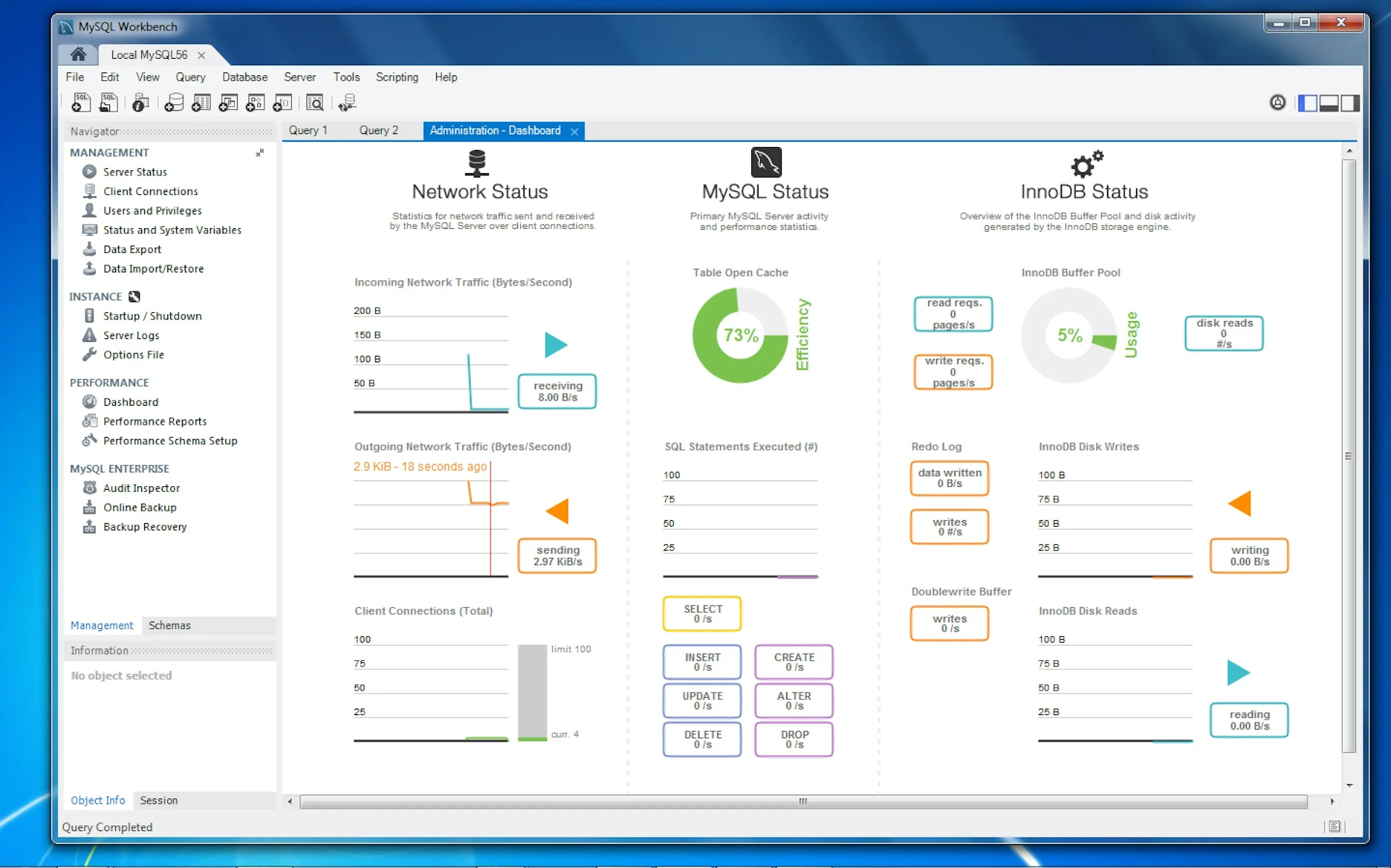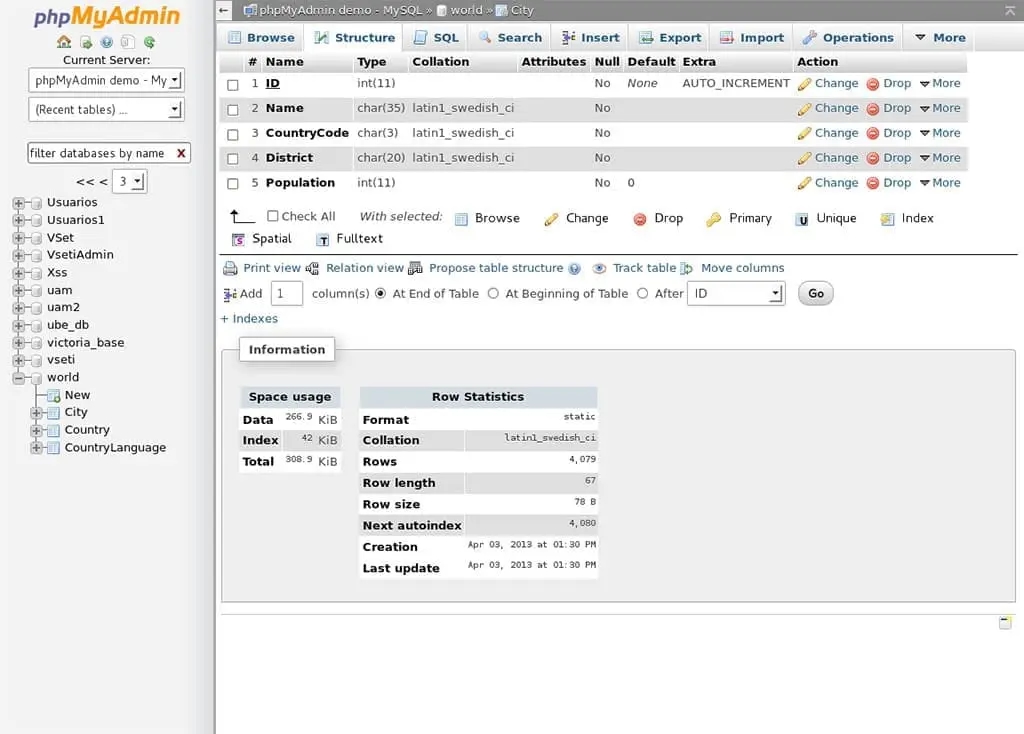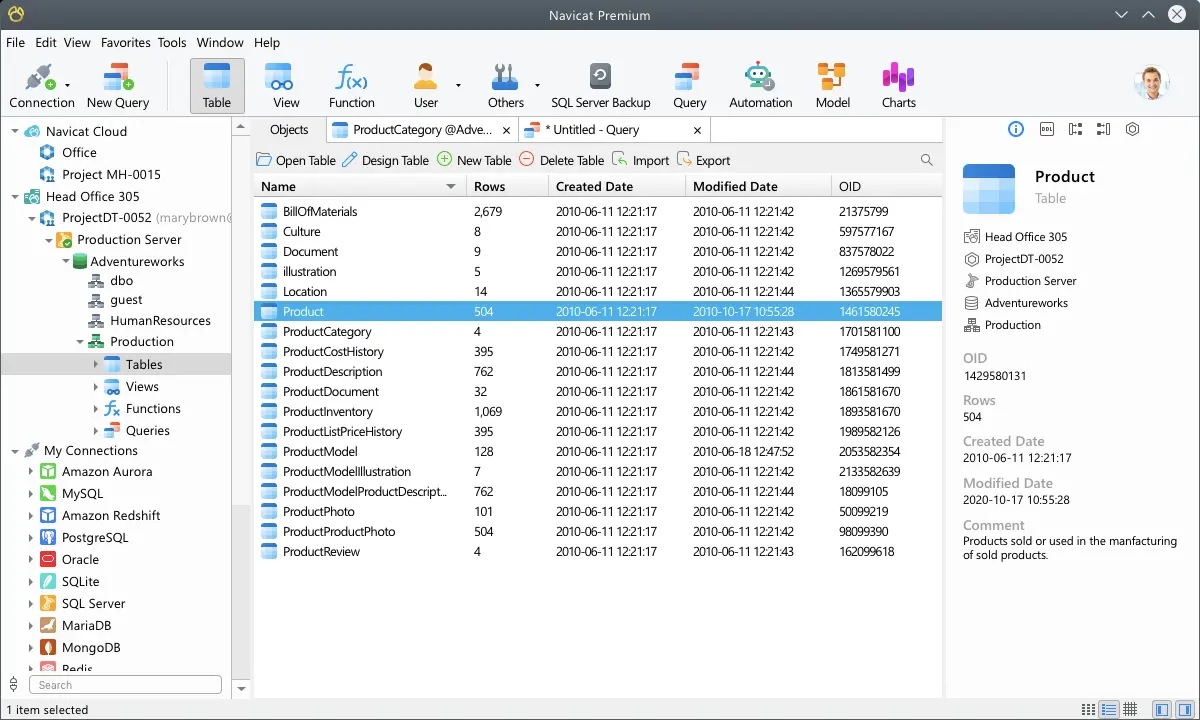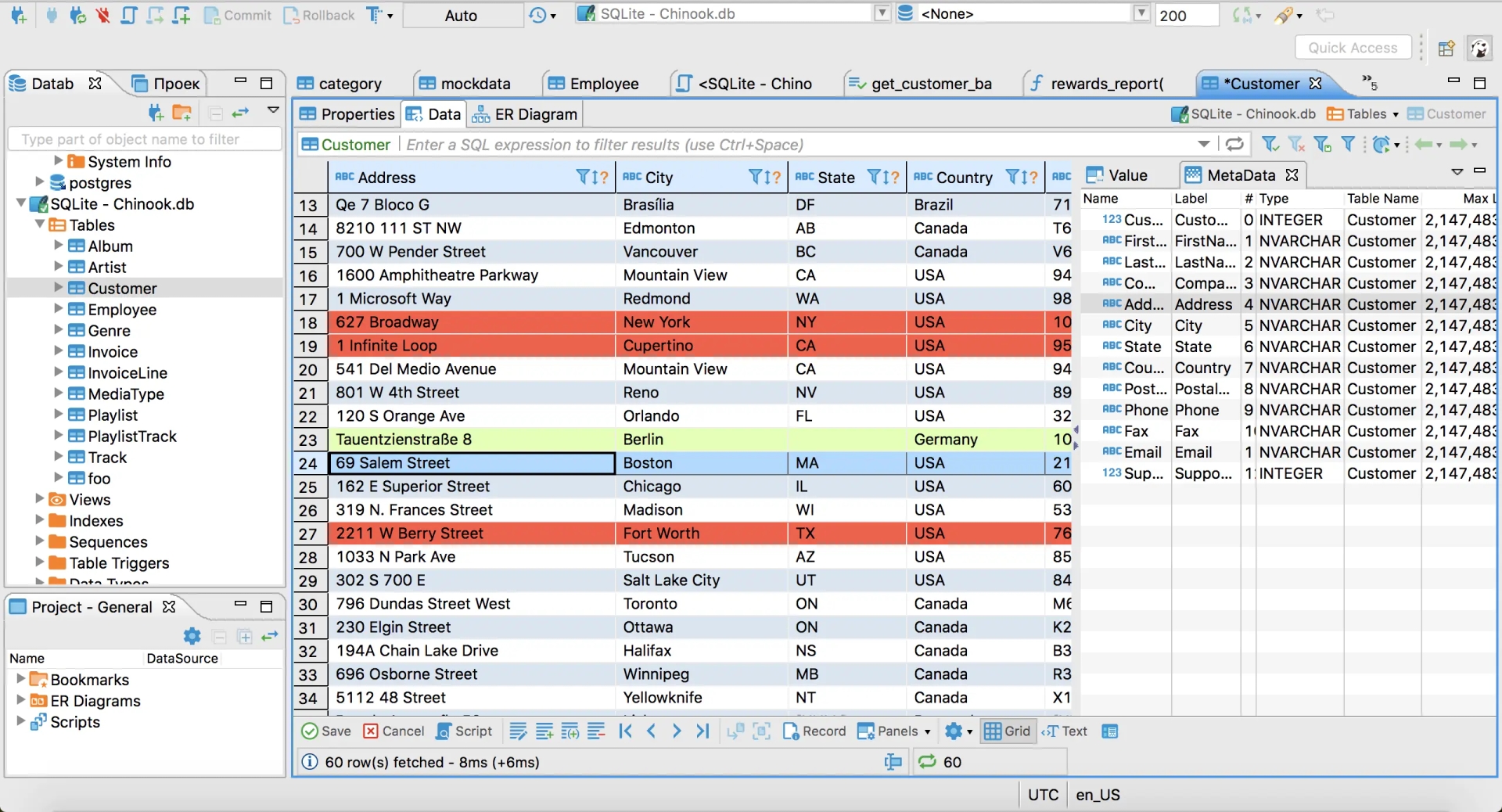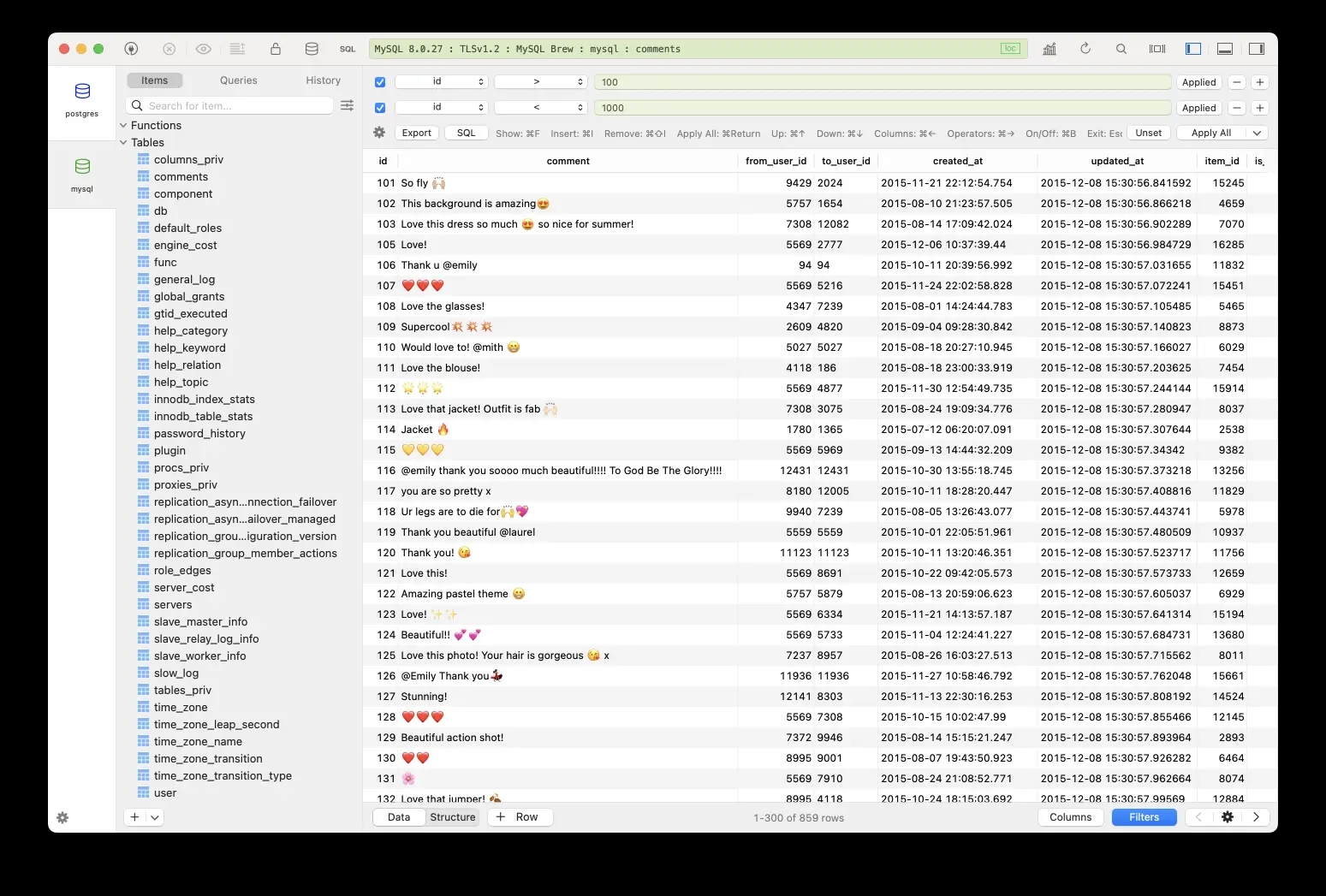Время на прочтение
6 мин
Количество просмотров 683K
Многие компании создают различные многофункциональные приложения для облегчения управления, разработки и администрирования баз данных.
Большинство реляционных баз данных, за исключением MS Access, состоят из двух отдельных компонентов: «back-end», где хранятся данные и «front-end» — пользовательский интерфейс для взаимодействия с данными. Этот тип конструкции достаточно умный, так как он распараллеливает двухуровневую модель программирования, которая отделяет слой данных от пользовательского интерфейса и позволяет сконцентрировать рынок ПО непосредственно на улучшении своих продуктов. Эта модель открывает двери для третьих сторон, которые создают свои приложения для взаимодействия с различными базами данных.
В Интернете каждый может найти много продуктов для разработки и администрирования баз данных MySQL. Мы решили собрать 10 самых популярных инструментов в одной статье, чтобы вы смогли сэкономить свое время.
1. Workbench
Первое место, по праву принадлежит инструменту Workbench (разработка компании Sun Systems/Oracle), который может работать на платформах Microsoft Windows, Mac OS X и Linux. Workbench объединяет в себе разработку и администрирование баз данных и является преемником DBDesigner4.
MySQL Workbench распространяется под свободной лицензией — Community Edition и с ежегодной оплачиваемой подпиской — Standard Edition. Последняя включает в себя дополнительные возможности, которые способны существенно улучшить производительность, как разработчиков, так и администраторов баз данных.
Скачать Workbench можно здесь dev.mysql.com/downloads/workbench
Стоимость — бесплатно.
Что делает Workbench популярным?
- возможность представить модель БД в графическом виде, а также редактирование данных в таблице;
- наличие простого и функционального механизма по созданию связей между полями таблиц, среди которых реализована связь «многие-ко-многим» с возможностью создания таблицы связей;
- функция Reverse Engineering позволяет восстанавливать структуру таблиц и связей из той, которая была реализована ранее и хранится на сервере БД;
- наличие редактора SQL-запросов, который дает возможность при отправке на сервер получать ответ в табличном виде и другие возможности.
2. Navicat
Второе место занимает Navicat (разработка компании PremiumSoft CyberTech Ltd) — инструмент для разработки и администрирования баз данных, который работает на любом сервере MySQL, начиная с версии 3.21. Для MySQL, Navicat доступен для работы на платформах Microsoft Windows, Mac OS X и Linux.
Подробнее о Navicat вы можете узнать здесь www.navicat.com/en/products/navicat_mysql/mysql_overview.html
Стоимость продукта варьируется от 199 до 379 долл. США.
Что делает Navicat популярным?
- наличие визуального конструктора запросов;
- возможность импорта, экспорта и резервного копирования данных;
- возможность создавать отчеты;
- SSH и HTTP туннелинг;
- миграция и синхронизация данных и структуры;
- инструмент для планирования задач и другие возможности.
3. PHPMyAdmin
PHPMyAdmin — бесплатное приложение с открытым кодом, предназначенное для администрирования СУБД MySQL. PHPMyAdmin представляет собой веб-интерфейс с помощью которого можно администрировать сервер MySQL, запускать команды и просматривать содержимое таблиц и БД через браузер.
Скачать PHPMyAdmin можно здесь www.phpmyadmin.net/home_page
Стоимость — бесплатно.
Что делает PHPMyAdmin популярным?
- возможность управлять СУБД MySQL без непосредственного ввода SQL команд;
- как панель управления PHPMyAdmin предоставляет возможность администрирования выделенных БД;
- интенсивное развитие;
- возможность интегрировать PHPMyAdmin в собственные разработки благодаря лицензии GNU General Public License и другие возможности.
4. dbForge Studio for MySQL
dbForge Studio for MySQL — инструмент, представляющий интерес как для пользователей MySQL, так и для разработчиков БД. С его помощью вы сумеете легко автоматизировать рутинную работу и сэкономить время. Сегодня dbForge Studio for MySQL представлен в трех редакциях: Express, Standard и Professional, что позволяет выбрать тот инструмент, который нужен именно вам. Пользоваться dbForge Studio for MySQL можно как коммерческой, так и бесплатной версией.
Ознакомиться с возможностями dbForge Studio for MySQL вы можете здесь www.devart.com/ru/dbforge/mysql/studio
Существует как бесплатная, так и платная версии, цена последней составляет 49,95 долл. США (стандартное издание ) и 99,99 долл. США (профессиональное издание).
Что делает dbForge Studio популярным?
- наличие средств для централизованного администрирования;
- инструменты для сравнения БД;
- визуальный профилировщик запросов;
- возможность управлять привилегиями пользователей;
- наличие Дизайнера БД, который позволяет строить визуальные диаграммы;
- улучшенная работа с проектами БД и другие возможности.
5. HeidiSQL
HeidiSQL — бесплатный инструмент для управления базами данных. Достойная альтернатива PHPMyAdmin, которая позволяет создавать и редактировать таблицы, представления, триггеры, процедура, а также просматривать и редактировать данные. Также HeidiSQL предоставляет возможность экспорта данных как в SQL файл, так и в буфер обмена на других серверах.
Скачать HeidiSQL можно здесь Сайт: www.heidisql.com
Стоимость — бесплатно.
Что делает HeidiSQL популярным?
- возможность подключаться к серверу с помощью командной строки;
- возможность пакетной оптимизации и восстановления таблиц;
- возможность редактирования столбцов, индексов и внешних ключей таблиц, редактирование тела и параметров SQL процедур, триггеров и др.;
- простое форматирование неупорядоченных SQL;
- синхронизация таблицы между разными базами данных и другие возможности.
6. SQL Maestro для MySQL
SQL Maestro для MySQL — инструмент для администрирования, разработки и управления наиболее востребованных СУБД. Удобный графический интерфейс дает возможность выполнять SQL запросы и скрипты, управлять привилегиями пользователей, экспортировать и создавать резервные копии данных.
Ознакомиться с возможностями и купить SQL Maestro для MySQL можно здесь www.sqlmaestro.com/products/mysql
В зависимости от выбранной лицензии и варианта использования, стоимость данного инструмента варьируется от 99 до 1949 долл. США.
Что делает SQL Maestro для MySQL популярным?
- поддержка версий MySQL сервера с версии 3.23;
- наличие конструктора баз данных;
- возможность редактирование, группировки, сортировки и фильтрации данных;
- визуальный конструктор запросов;
- SSH и HTTP туннелинг;
- BLOB-редактор и другие возможности.
7. EMS SQL Manager для MySQL
EMS SQL Manager для MySQL — инструмент для разработки и администрирования баз данных, который поддерживает различные функции MySQL и работает со всеми версиями MySQL старше 3.23. С его помощью у вас есть возможность визуально редактировать, импортировать и экспортировать БД, выполнять сценарии SQL, управлять привилегиями пользователей, визуально проектировать базы данных MySQL.
Подробнее ознакомиться и приобрести EMS SQL Manager для MySQL можно здесь www.sqlmanager.net./ru/products/studio/mysql
Существует платная и бесплатная версии приложения. Последняя имеет ряд функциональных ограничений. Стоимость платной версии варьируется в пределах 95 – 245 долл. США.
Что делает EMS SQL Manager for MySQLпопулярным?
- поддержка данных UTF8;
- простое управление различными объектами MySQL;
- совместимость со всеми версиями с 3.23 по 6.0 включительно;
- наличие графических и текстовых инструментов для формирования запросов;
- SSH и HTTP туннелинг;
- удобный конструктор отчетов и другие возможности.
8. SQLyog
SQLyog — один из наиболее мощных инструментов, который сочетает в себе возможности MySQL Administrator, PHPMyAdmin и некоторые другие инструменты для администрирования и разработки баз данных. SQLyog работает на платформах Microsoft Windows, Windows NT. и Linux с помощью Wine.
Подробнее ознакомиться и приобрести SQLyog можно здесь www.webyog.com/en/index.php
Доступна как бесплатная, так и платная версия SQLyog. Стоимость платной версии — от 99 до 1499 долл. США (варьируется в зависимости от количества пользователей и лицензии, с поддержкой или без нее).
Что делает SQLyog популярным?
- удобный конструктор запросов;
- возможность синхронизации данных;
- поддержка юникода;
- SSH и HTTP, HTTPS туннелинг;
- «умное» автозавершение работы;
- интеллектуальное дополнение кода и другие возможности.
9. DBTools Manager
DBTools Manager — приложение для управления данными, с встроенной поддержкой MySQL, PostgreSQL, MSAccess, MSSQL Server, Oracle и других БД. Поддерживаемые платформы: Windows 2000, XP, Vista, 7.
DBTools Manager представлен в бесплатном (Standard) и платном варианте (Enterprise). Стоимость составляет 69.90 долл. США за одну лицензию, при покупке нескольких лицензий предусмотрены скидки.
Подробнее ознакомиться и приобрести DBTools Manager можно здесь www.dbtools.com.br/EN/dbmanagerpro
Что делает DBTools Manager популярным?
- управление базами данных, таблицами;
- наличие редактора запросов;
- наличие мастера создания форм и отчетов;
- возможность импорта и экспорта данных из различных источников, среди которых MSAccess, MSExcel, Paradox, FoxPro, DBF, ODBC таблицы, текстовые и XML файлы;
- конструктор диаграмм и другие возможности.
10. MyDB Studio
MyDB Studio — бесплатный инструмент для администрирования БД MySQL, который позволяет создавать, редактировать и удалять записи, таблицы и базы данных. Работает исключительно на платформе Windows.
Скачать MyDB Studio можно здесь www.mydb-studio.com
Стоимость — бесплатно.
Что делает MyDB Studio популярным?
- возможность подключаться к неограниченному количеству баз данных;
- возможность подключения по SSH каналам;
- создание откатов и экспорт БД в различные форматы;
- возможность переноса, резервного копирования, также восстановления БД и другие возможности.
Top 10 Best MySQL GUI Client Tools for Linux and Windows. MySQL is an open source relational database management system, used to store structured data in rows and columns. The structured data is in tables and is used together with other data sets. When working with a MySQL database, database admins and developers perform various tasks: developing queries, troubleshooting, maintaining objects, and more. Without the help of a graphical user interface, these tasks would be too difficult to handle.
MySQL GUIs are designed to make it easier for you to administer your databases graphically instead of typing SQL instructions. Here are top of 10 best MySQL GUI client tools for Linux and Windows:
Let’s start the article Top 10 Best MySQL GUI Client Tools for Linux and Windows.
Top 10 Best MySQL GUI Client Tools for Linux and Windows
1. DBeaver

DBeaver is a universal, multi database GUI based software. Highly functional, user friendly, and open source. Features include a friendly UI, a powerful SQL query editor, database comparison, a visual query builder, ER diagrams, and test data generation. Although DBeaver supports all databases that contain a JDBC driver, it also manages external data sources that contain a JDBC driver.
Pros of DBeaver
- Capable of handling complex connection configurations.
- Handles and organizes queries for many different kinds of databases.
- Lets you identify and track different types of DB connections by colour code.
- With DBeaver you navigate between different simultaneous DB connections.
Cons of DBeaver
- Does not support multiple queries in one editor.
2. MySQL Workbench

MySQL Workbench is a unified visual tool for database developers, system admins, and architects. Provides users with SQL development, data modelling, and extensive admin tools, data backup, server configuration, and more. Default Linux MySQL GUI client, also compatible with macOS and Windows.
This tool allows you to visually design, model, create, and manage databases. Has all the functionalities that you would need to create complicated ER models and perform forward and reverse engineering. Features functionalities to perform complex change management and documentation tasks that usually consume a lot of time and effort.
Pros of MySQL Workbench
- Solid data security layer to protects sensitive information from intruders.
- Free, simple and easy to use.
- Compatible with Linux, Windows, and most variations of UNIX.
- Extremely scalable and handles more than 50 million rows.
Cons of MySQL Workbench
- Its debugging tool is not very efficient when compared to other products.
- The earlier versions of MySQL Workbench do not support COMMIT, stored procedure, and ROLE.
- Not very effective in managing very large databases.
3. Beekeeper Studio

Moreover, Beekeeper studio gives you the option of encrypting your saved connection passwords, which also improves your security posture. Additionally, you create tables without writing SQL. The tools SQL table creator allows you to generate, modify, and delete table columns in just a few clicks.
Pros of Beekeeper Studio
- Lightweight and fast.
- Supports multiple database platforms.
- Simple tabbed user interface that is easy to use and follow.
- Free and open source.
- Has a useful auto complete functionality.
Cons of Beekeeper Studio
- Takes some time to load tables.
- The user interface is not very interactive.
- Quite lightweight and lacks some performance.
4. Valentina Studio

Valentina Studio is an innovative and versatile database admin software. Offers database admins and developers advanced functionalities for schema, database modelling, query building, editing, and business intelligence reporting. With Valentina Studio, you enhance how you manipulate, explore, and analyse the contents of your database.
Lets you build and edit forms visually so you study the data in databases more systematically. Swiftly migrate data from one database to another. Use Valentina Studio’s tool for reverse and forward engineering.
Pros of Valentina Studio
- Supports most of the databases available in the market including MySQL, MSSQL, PostgreSQL, and more.
- Provides users with a large variety of database continuous integration tools.
- Very responsive user interface.
- Works on Linux, Windows, and X operating systems.
Cons of Valentina Studio
- The performance and boot up speeds are a bit slower compared to other MySQL clients.
- The user interface has list view, which makes it look cluttered.
5. Aqua Data Studio

Aqua Data Studio is a universal database development ecosystem that improves the productivity of data admins. From database building, streamlining data analysis, designing, this software helps you perform your tasks much easier, whether you are handling relational, NoSQL, or cloud native databases. Aqua Data Studio IDE allows users to view their data using beautiful and shareable dashboards and visuals.
Lets you perform queries on database servers automatically with excel like grid that you use to modify the data within the tables. Another cool feature of Aqua Data Studio is the ability to track and debug functions, archived procedures, and packages via SQL debuggers.
With sophisticated Query Analyzer it allows you to connect to any database server and perform SQL queries. Syntax colouring, autocomplete, and SQL formatting tools help reduce the time you spend writing SQL statements. View the query results in text, pivot, grid, or form views using the quick filter and export functionality.
Pros of Aqua Data Studio
- Provides users with a convenient and intuitive digital workspace.
- Lets you easily analyse and share visuals and data.
- Has numerous automated and modern querying tools.
- Supports database reverse engineering.
Cons of Aqua Data Studio
- Relatively expensive.
- Has errors that negatively impact its performance.
6. Navicat for MySQL

Offers intuitive and robust GUI for database management, maintenance, and development. Local backup/restore functionality guides you through the entire backup process, while minimizing potential errors. Use this feature to automate repeatable deployment processes like script execution and database backup.
Basically, it has one of the best security features of any MySQL GUI’S. Establish secure connections through SSH Tunneling and SSL. Supports various database authentication approaches like PAM authentication. More to add, it provides you with multiple options for migration. Data Synchronization, Data Transfer, and Structure Synchronization features offer you an easy way to migrate your data for less overhead.
Pros of Navicat for MySQL
- Easily configures and stores credentials and network information for multiple connections.
- Supports complex job scheduling options and construction of singular and batched jobs.
- Robust data browser view allows inexperienced users SQL to quickly and easily filter datasets.
- Supports access through standard HTML.
Cons of Navicat for MySQL
- A lot of documentation versions available, which is confusing.
7. SQLyog

SQLyog is a content management tool for Windows that allows you to create schemas and compare databases. Gives you a visual overview of all your database info, including related formulas and schemas. Use SQLyog to lay out the contents of your database in easy to read table schemas. Rapid checksum algorithm also lets you periodically replicate data. All this is achieved through its built in Database Synchronization wizard.
With wide range of built-in wizards, they facilitate the automation of installation and registration, while others help in the compression of scheduled backups, and HTTP/HTTPS tunnelling connectivity. Software handles database content through a master table lookup, a favorites manager, as well as a multicolored tabbed interface for better readability.
Pros of SQLyog
- Free community edition.
- Migration tools to support copying of the database.
- Supports a wide variety of database options including CA IDMS/DB.
- Database diagnosis feature for analysing and repairing databases.
Cons of SQLyog
- Only available for Windows OS.
- You have to pay for advanced premium features.
8. Toad Edge

Toad Edge is a lightweight flexible and extensible MySQL client that simplifies the development and administration of MySQL. Uses Windows to run your onsite or cloud based databases like MySQL, PostgreSQL, MariaDB, Amazon Redshift, Microsoft Azure, and Amazon Aurora. Intuitive interface and shallow learning curve enables you to master new database platforms easily.
Pros of Toad Edge
- Easy to use interface that shortens your learning curve and improves productivity.
- Supports multiple databases and OS platforms including Windows and Mac.
- Offers users world class technical support and self help tools that allow you to resolve problems easily.
- Easily manage and edit database objects and manage user privileges.
- Easily exports data from tables.
Cons of Toad Edge
- Does not have a free version.
- Too many options and editions available which might be confusing to some users.
9. phpMyAdmin

phpMyAdmin is a free PHP based MySQL GUI client that focuses on the admin of MySQL over the web. Contains all the basic features that database administrators need to operate on MySQL and MariaDB. Its ease of use makes it one of the most popular tools for MySQL database management.
With phpMyAdmin, you create, modify, update, drop, import, export, and delete MySQL database tables. Although it lacks some of the advanced functionalities other tools have, its basic features are capable of managing databases, tables, relations, users, permissions, columns, and indexes in MySQL. Execute all these operations through the user interface, or execute direct instructions for more advanced SQL statements.
Currently, phpMyAdmin has translations in more than 70 languages and also supports LTR and RTL languages.
Pros of phpMyAdmin
- Web based application and is accessed from any computer.
- Users conveniently manage all the database elements using the user interface, which is much easier than the MySQL command-line editor.
- Allows users to run multiple servers simultaneously.
- phpMyAdmin supports several backup formats including XML, SQL, CSV, PDF, Word, OpenDocument Text, Excel, Spreadsheet, and more
Cons of phpMyAdmin
- Complex installation process. You have to install Apache Web Server, MySQL, and PHP and then configure each. of these software individually.
- It does not have an auto compilation functionality.
10. Devart dbForge Studio for MySQL

Devart dbForge Studio for MySQL is a universal IDE for MySQL database development, admin and management. Fully featured MySQL GUI that enables you to generate and run queries, analyse data, automate database object management, develop and debug stored routines, compare and synchronize databases, and more.
MySQL intelligent SQL coding helps you conveniently write SQL code through features such as intelligent formatting, code completion, and code snippets. Fill MySQL databases with external data using the export and import tools. Supports more than 10 popular data formats and allows you to customize the entire process.
Additionally, the tool also provides templates, automating data import and data export tasks via the command line. dbForge has a data generator that lets you populate your MySQL tables with thousands of rows of test data. Data Generator not only supports every MySQL data type but also has a lot of meaningful generators with customizable settings.
Pros of dbForge Studio
- Very useful tools for data and database schemas.
- Store code snippets for later use.
- Helpful suggestions while typing queries.
- Great debugging support.
- Clean and intuitive user interface for monitoring SQL server performance.
Cons of dbForge Studio
- Relatively expensive.
- Does not support noSQL.
Top 10 Best MySQL GUI Client Tools for Linux and Windows Conclusion
With the above MySQL GUI client tools, managing your database system is much easier. These tools are designed to help users interact with data more effortlessly without complex querying or SQL commands. Besides, they are multi featured to support all sorts of workloads on MySQL.
To interact with MySQL databases, it’s common to employ MySQL GUI clients. They enable users to visually view, create and modify database objects such as tables, rows, and columns. Some familiar features of MySQL GUI clients include SQL generator and export data, which makes designing, creating, and administering MySQL databases easier and more convenient. Here, we gathered 5 best MySQL GUI Clients on the market right now.
The Official: MySQL Workbench
MySQL Workbench is a free database design and model access tool for MySQL, meant for database architects, developers, and of course, DBAs. It is available on Windows, Linux, as well as MacOS. Since the official MySQL vendor offers it, it looks like it’s going to be free and maintained for the foreseeable future.
MySQL Workbench’s main features can be grouped threefold:
-
Database design and modeling: you can create and edit your databases, tables, and their relationships visually. The ER diagram comes in handy for complex database architecture.
-
SQL development: with the built-in SQL editor, you can build, edit, and run SQL queries against MySQL databases. It includes some useful mechanisms to aid in writing and debugging SQL statements, including color syntax highlighting, context-sensitive help, and auto-complete.
-
Server Administration: MySQL Workbench offers a centralized platform to manage user accounts, export/import data, backup/restore databases, monitor server performance, and more to ease admin work.
The Old School: phpMyAdmin
phpMyAdmin is a web-based interface to MySQL and MariaDB written in PHP that was first released back in 1998. It’s open-source and free to use. For over 20 years, phpMyAdmin remains one of the most popular administration tools for MySQL databases, with a large community of users and contributors.
A range of features are available (managing databases, tables, users, permissions, etc) and can be performed via the user-friendly interface, you can also execute SQL queries directly. However, being web-based has pros and cons: phpMyAdmin is available on all the platforms with a web browser, yet it can be prone to security attacks such as SQL injection, so make sure to take proper precautionary measures.
The Power Couple: Navicat & DBeaver
Navicat
Navicat’s first release came in 2002 and back then, it was a simple application only available for MySQL on Windows. Now it’s available on macOS and Linux, with a long list of compatible databases, including Redis, PostgreSQL, SQL Server, Oracle, MariaDB, SQLite, MongoDB, and a handful of cloud databases.
It is not open-source, nor does it have a free offering, you can only choose between the premium and lite (with a compact list of features and database support as compared to the premium versions.
With Navicat, you can connect to multiple databases on a single GUI, which is convenient to manage and compare data across different platforms.
Other features Navicat offers include data modeling and design, data synchronization between databases, backup and restore, data import/export, and SQL Development (it has a built-in SQL editor for users to write and optimize SQL queries).
Overall, Navicat is a comprehensive database management tool for novice and experienced users.
DBeaver
Unlike Navicat, which only offers commercial versions, DBeaver offers both open-source and commercial products. It started as a hobby project back in 2010 and was open-sourced for use in 2013. The OS version caters to most database management and administration needs, while the commercial version extends the capabilities with additional advanced features like reverse engineering, data modeling, collaboration tools, and tech support.
Currently, it supports 80+ databases (SQL, NoSQL, document-oriented, key-value, big data, cloud, you name it). DBeaver is a desktop client, if you prefer web-based tools, they also have CloudBeaver.
The Starlet: TablePlus
Starting in 2017, TablePlus is the newbie on the list, and its modern and simple UI reflects it. It supports most relational databases and some NoSQL ones. When they just started, they only supported macOS, but it is now available on Windows, Linux, and iOS (!). It is not open-source, but the roadmap is open and anyone can open an issue on their GitHub Issue Tracker. TablePlus has two plans: a free tier (has no limit on trial time) and a paid subscription model (license) with extended features.
It’s worth mentioning that DBngin, a tool to spin up a local database server (currently supports PostgreSQL, MySQL, and Redis) on your Mac, belongs to TablePlus and is open-source. You can connect it to TablePlus, meaning you can manage your local databases visually all in one go.
Final Thoughts
MySQL GUI Clients can be used to help you manage databases with more confidence. However, choosing the right option for your organization is important.
Any of the aforementioned provides a UI for users to operate on databases, a SQL Editor, and the ability to export data. On the other hand, if your organization needs are beyond those and demands an extra layer of control over database queries, changes, and admin actions, you can try our Bytebase, an open-source Database DevOps and CI/CD tool for teams, designed to centralize the control and secure your organization’s most valuable asset, the database data.
Further Readings
- Top MySQL Schema Compare Tool to Diff and Sync Database
- Top Open Source SQL Clients
- Top Database Schema Migration Tools
- Top DBeaver Alternatives
MySQL — одна из самых популярных систем управления базами данных, которая широко используется для разработки веб-приложений и сайтов. На Windows также существует множество оболочек, которые облегчают работу с MySQL и предоставляют удобный интерфейс для управления базами данных. В этой статье мы рассмотрим несколько лучших программ для работы с MySQL на платформе Windows.
Одной из самых популярных оболочек для MySQL на Windows является phpMyAdmin. Это бесплатная программа с открытым исходным кодом, которая предоставляет удобный веб-интерфейс для управления базами данных MySQL. PhpMyAdmin позволяет выполнять все основные операции с базой данных, включая создание, редактирование и удаление таблиц, выполнение SQL-запросов и экспорт данных в различные форматы.
Еще одним популярным инструментом является MySQL Workbench. Это мощная оболочка для разработчиков и администраторов баз данных MySQL, которая предоставляет широкие возможности для создания, модификации и визуализации структуры базы данных. MySQL Workbench также включает в себя инструменты для выполнения SQL-запросов, импорта и экспорта данных, а также отладки и тестирования запросов.
Кроме того, существуют и другие оболочки, такие как HeidiSQL, Navicat и SQLyog, которые также пользуются популярностью среди разработчиков и администраторов баз данных MySQL под Windows. Каждая из этих программ имеет свои особенности и преимущества, и выбор конкретной оболочки зависит от потребностей и предпочтений пользователя.
Содержание
- Оболочка для MySQL под Windows: лучшие программы
- Управление базами данных с помощью оболочки MySQL
- Выбор оболочки для MySQL под Windows
- Особенности и преимущества программ для управления MySQL
- Список лучших программ для управления базами данных MySQL
Оболочка для MySQL под Windows: лучшие программы
В операционной системе Windows для управления базами данных MySQL можно использовать различные программы, которые предоставляют удобный графический интерфейс и широкий набор функций.
Рассмотрим некоторые из лучших оболочек для работы с MySQL:
| Название программы | Описание | Стоимость |
|---|---|---|
| phpMyAdmin | Бесплатная и одна из самых популярных оболочек для MySQL. Обладает широким набором функций и интуитивно понятным интерфейсом. | Бесплатно |
| HeidiSQL | Бесплатная программа с удобным графическим интерфейсом. Поддерживает возможность работы с несколькими серверами одновременно. Имеет широкий набор инструментов для работы с базами данных. | Бесплатно |
| SQLyog | Платная программа с продвинутыми функциями и профессиональным интерфейсом. Предлагает различные инструменты для управления базами данных и автоматизации задач. | Платно |
| Navicat | Мощная коммерческая оболочка, поддерживающая не только MySQL, но и другие СУБД. Имеет богатый функционал и интуитивно понятный интерфейс. | Платно |
Выбор оболочки для работы с MySQL зависит от ваших потребностей и предпочтений. Большинство программ предлагают бесплатные версии со всеми необходимыми функциями, однако для более расширенного набора возможностей может потребоваться приобретение платной версии.
Управление базами данных с помощью оболочки MySQL
Одним из самых популярных и удобных инструментов для управления базами данных MySQL является MySQL Workbench. Он предоставляет удобный графический интерфейс, позволяющий выполнять все основные операции с базами данных. В MySQL Workbench можно создавать новые базы данных, таблицы, выполнять запросы, импортировать и экспортировать данные и многое другое.
Еще одной популярной оболочкой для MySQL является phpMyAdmin. Он представляет собой веб-интерфейс, который позволяет управлять базами данных MySQL через веб-браузер. С помощью phpMyAdmin можно создавать, изменять и удалять таблицы, выполнять запросы, экспортировать и импортировать базы данных и многое другое. Благодаря своей простоте использования, phpMyAdmin является популярным выбором для многих разработчиков и администраторов баз данных.
Кроме MySQL Workbench и phpMyAdmin, существует еще ряд других оболочек для MySQL, таких как SQLyog, Navicat, HeidiSQL и многие другие. Каждая из этих оболочек имеет свои особенности и функциональность, и выбор зависит от ваших потребностей и предпочтений.
В заключение, использование оболочек для MySQL позволяет значительно упростить управление базами данных, делая процесс более удобным и эффективным. Выбор конкретной оболочки зависит от ваших потребностей, но независимо от выбора, вы обязательно найдете инструмент, который поможет вам вести базы данных на Windows.
Выбор оболочки для MySQL под Windows
Выбор оболочки для управления базами данных MySQL под Windows может быть сложной задачей, учитывая большое количество доступных программ. Важно найти подходящее решение, которое будет сочетать в себе функциональность, удобство использования и надежность.
При выборе оболочки для MySQL под Windows следует обратить внимание на следующие основные факторы:
1. Функциональность:
Оболочка должна предоставлять все необходимые функции для управления базами данных, включая создание, удаление, изменение таблиц, выполнение SQL-запросов, импорт и экспорт данных и другое. Также важно, чтобы оболочка поддерживала специфические для MySQL функции, такие как хранимые процедуры, триггеры и т.д.
2. Интерфейс пользователя:
Оболочка должна иметь интуитивно понятный и удобный интерфейс пользователя, чтобы даже новички могли легко ориентироваться и выполнять необходимые операции. Важно, чтобы интерфейс был чистым, наглядным и имел удобную навигацию.
3. Поддержка:
Разработчики оболочки должны предоставлять регулярные обновления и техническую поддержку, чтобы гарантировать надежность и безопасность использования. Также важно проверить активность сообщества пользователей оболочки и наличие документации, форумов и других ресурсов для решения возможных проблем.
На рынке существует множество оболочек для MySQL под Windows, таких как MySQL Workbench, Navicat, HeidiSQL, phpMyAdmin и другие. Каждая из них имеет свои преимущества и недостатки. Необходимо провести сравнение и выбрать наиболее подходящую оболочку, учитывая свои конкретные потребности и предпочтения.
Независимо от выбранной оболочки, важно помнить о безопасности и сохранении резервных копий баз данных. Также рекомендуется регулярно обновлять оболочку и следить за новыми версиями, чтобы использовать все возможности и исправления, предлагаемые разработчиками.
В итоге, выбор оболочки для MySQL под Windows зависит от конкретных условий и потребностей пользователя. Однако, проведя исследование и учитывая основные факторы, можно найти оптимальное решение, которое будет соответствовать требованиям и облегчить работу с базами данных.
Особенности и преимущества программ для управления MySQL
Программы для управления базами данных MySQL предоставляют широкий набор инструментов и функций, которые значительно облегчают работу с базами данных. Вот основные особенности и преимущества подобных программ:
| Удобный интерфейс пользователя | Программы обладают интуитивно понятным интерфейсом, позволяющим быстро освоиться и начать работу с базами данных без лишних затрат времени и усилий. Визуальные элементы и функциональные возможности программы позволяют легко выполнять операции по созданию, редактированию и удалению данных. |
| Управление базами данных в реальном времени | Программы обеспечивают возможность мониторинга и управления базами данных MySQL в реальном времени. Это позволяет оперативно реагировать на изменения в базах данных, контролировать производительность и выполнение запросов. |
| Поддержка широкого спектра функций и операций | Программы предоставляют множество функций и операций для работы с базами данных. Это включает создание, редактирование и удаление таблиц и баз данных, выполнение SQL-запросов, импорт и экспорт данных, а также управление пользователями и правами доступа. |
| Удобство и гибкость настройки | Программы для управления MySQL обычно предоставляют возможность гибкой настройки для адаптации под индивидуальные потребности и предпочтения каждого пользователя. Это включает настройку внешнего вида интерфейса, режимов работы, панели инструментов и других параметров. |
| Поддержка различных версий MySQL | Программы обычно поддерживают разные версии MySQL, что позволяет использовать их с новыми и старыми версиями баз данных. |
| Безопасность и надежность | Программы оснащены средствами обеспечения безопасности и надежности данных. Это включает аутентификацию пользователей, шифрование данных в процессе передачи, резервное копирование и восстановление данных, а также контроль доступа к базам данных и таблицам. |
Таким образом, программы для управления базами данных MySQL предлагают множество преимуществ и удобств, которые помогают эффективно работать с базами данных и обеспечивают безопасность и надежность данных.
Список лучших программ для управления базами данных MySQL
2. HeidiSQL – это бесплатная программа для управления базами данных MySQL, которая предлагает удобный визуальный интерфейс для работы с базами данных. Она поддерживает множество функций, включая редактирование таблиц, выполнение запросов, импорт и экспорт данных и многое другое.
3. MySQL Workbench – это официальная программа от MySQL для управления базами данных. Она предлагает широкий набор функций, включая создание и редактирование таблиц, моделирование баз данных, выполнение запросов, импорт и экспорт данных, а также инструменты для администрирования и мониторинга баз данных.
4. Navicat for MySQL – это коммерческая программа для управления базами данных MySQL, которая предлагает мощные инструменты для работы с базами данных. Она поддерживает множество функций, включая создание и редактирование таблиц, выполнение запросов, импорт и экспорт данных, а также инструменты для администрирования и мониторинга баз данных.
5. SQLyog – это коммерческая программа для управления базами данных MySQL, которая предлагает простой и интуитивно понятный интерфейс. Она поддерживает множество функций, включая создание и редактирование таблиц, выполнение запросов, импорт и экспорт данных, а также инструменты для администрирования и мониторинга баз данных.
Это лишь небольшой список программ для управления базами данных MySQL. В зависимости от ваших потребностей и предпочтений, вы можете выбрать программу, которая наиболее удобна для вас.
MySQL Database
MySQL is among the most widely-used and popular database technologies. Ahead of SQL databases like Postgres and SQLite, MySQL has been the more popular choice for many years. This article compares some of the best MySQL GUIs for database developers and administrators.
Developers and database managers are faced with a number of tasks when working with a database such as creating and executing queries, managing objects, debugging, etc. This can quickly become challenging to manage. Database GUIs have been created in order to make it easy to manage MySQL databases visually, without having to manually type SQL commands. GUIs make the processes of designing, creating, and administering databases easier and more convenient.
1. mySQL Workbench
MySQL Workbench is a unified visual tool for database architects, developers, and DBAs. A full-fledged GUI solution, MySQL Workbench offers functionality to design, develop, and administer your MySQL database. This is the only SQL client which is supported and developed by Oracle, the company behind MySQL itself. So you can be sure that it will contain all recent features to match the updates for MySQL’s server.
Pros:
- Create and manage database-server connections, connection parameters, and integrated query execution
- Assemble data into meaningful graphical designs
- Table Editor makes it easy to alter tables, columns, indexes, triggers, options, privileges, inserts, and partitioning
- MySQL Enterprise support. Regularly maintained
- See server status and health, as well as server logs – using intuitive dashboards
- Available for Linux, Mac and Windows
- available in 3 editions – Community, Standard, and Enterprise. Community is a free open-source edition offering a basic set of features, and the remaining two are commercial editions with extended functionality.
Cons:
- Sometimes buggy. Some users have reported it tool crashes
- Sometimes large queries can’t be stopped and have to be forcefully killed. In some cases, the entire application has to be killed.
Installation process:
You can download the MySQL Workbench installer from the official MySQL website and follow the prompts to install it on your machine.
Use-cases supported:
MySQL Workbench is a comprehensive database design and management tool that supports tasks such as schema design, SQL development, server administration, data migration, and backup/restore operations.
Cost:
MySQL Workbench is free and open-source software.
2. dbForge
The dbForge GUI is the best option when it comes to IDE for MySQL. It’s the first thing that pops out when you search for it online. A positively reviewed database GUI, dbForge is a multi-purpose tool that offers a lot of worthwhile features and functionality necessary for MySQL database development and maintenance.
dbForge helps in creating and executing queries, developing and debugging stored routines, and automating database object management, and much more.
Pros:
- It can connect to a number of MySQL flavours – MariaDB to Percona to even Alibaba cloud’s MySQL
- Query profiler helps DBAs capture different session statistics such as execution time, query plan, status variables
- dbForge uses MySQL native commands like EXPLAIN and SHOW PROFILE to gather session data and presents it in an easy-to-understand format in the GUI
- Master-detail browsers, pivot tables and MS Access style reporting helps in data analysis
- GUI functionalities can be saved as command-line outputs before you run them
- Use text-based commands for automating tasks like backups or data import/exports
- Natively import JSON, XML, Google Sheets, Excel, Access or ODBC databases
Cons:
- Complete version can be expensive for some users
- Very basic JSON viewer (for example, no ways to collapse or expand blocks of data).
- Users report that in some cases the autocomplete feature stops working, whenever many connections are opened.
Installation process:
You can download the dbForge installer from the Devart website and follow the prompts to install it on your machine.
Use-cases supported:
dbForge is a MySQL GUI that offers tools for schema management, query development, data analysis, and server administration. It also supports working with other database systems such as Oracle, SQL Server, and PostgreSQL.
Cost:
dbForge comes in both free and paid versions, with the paid versions starting at $109/ year offering more advanced features.
3. dBeaver
DBeaver is another open-source cross-platform GUI tool popularly used for SQL databases by both developers and database administrators. The GUI allows you to navigate easily through your data and perform full-text searches to create filtered tables and views. DBeaver runs as a desktop application. The process of connecting it to your local database is very intuitive and you don’t need to have CLI experience to get started with this tool.
This tool supports the import and export of data with many file formats such as CSV, HTML, XML, JSON, XLS, XLSX. You can also use this tool to generate ER diagrams for a database/schema.
Pros:
- DBeaver connects to any database which has a Jdbc driver – such as MariaDB, Sybase, SQLite, Oracle, SQL Server, DB2, MS Access, Firebird, Teradata, Apache Hive
- You can run DBeaver MySQL GUI on Windows, Linux, and macOS
- Table Editor makes it easy to alter tables, columns, indexes, triggers, options, privileges, inserts, and partitioning
- create multiple data views to support a variety of user needs.
- It has a free open-source edition as well as an enterprise edition. You can buy the standard license for the enterprise edition at $199.
- Easy Import/Export/Backup
- Mock Data Generator
Cons:
- It can be a bit slow when dealing with large data sets compared to some expensive GUI tools
- Sometimes buggy
- Sometimes large queries can’t be stopped and have to be forcefully killed. In some cases, the entire application has to be killed.
Installation process:
You can download the dBeaver installer from the official website and follow the prompts to install it on your machine.
Use-cases supported:
dBeaver is a universal database tool that supports multiple database systems including MySQL, PostgreSQL, Oracle, SQL Server, and more. It offers features such as data editing, SQL query development, schema management, and data transfer.
Cost:
dBeaver is free and open-source software, but a paid version starting $99 with additional features is also available.
4. PHPMyAdmin
PHPMyAdmin is another widely popular web-based MySQL administration tool written in PHP.
Easy to install and use, PHPMyAdmin is completely free to use. Allows you to use either the GUI or direct commands.
It sports basic functionality, enough to help users create functioning websites without having the expertise in MySQL. Over the years, however, it has had the time to develop and enhance the tool for a bunch of top requested features. Database administrators and architects can use the tool to handle tasks ranging from simple to complex such as creating multi-format database graphics.
Pros:
- Support for MySQL functions like browse or drop for tables, databases, fields, views, and indexes
- Importing and exporting data in a wide range of formats
- Transformation of stored data using predefined functions and formats
- Can be easily accessed from most computers because it’s web-based
- Simple to install and use
- Available in 80 languages – both left-to-right and right-to-left ones, making it accessible for global users
Cons:
- It cannot be used for any and all databases, as it supports only MySQL and MariaDB
- Though it supports the classic servers and systems, its growth is not parallel to the technological growth of the current industry standards
Installation process:
PHPMyAdmin is a web-based tool that can be installed on a web server. You can download the latest version from the official website and follow the instructions to set it up on your server.
Use-cases supported:
PHPMyAdmin is primarily used for managing MySQL databases through a web interface. It offers features such as query development, data manipulation, schema management, and server administration.
Cost:
PHPMyAdmin is free and open-source software.
5. HeidiSQL
HeidiSQL is a lightweight freeware tool for working with databases. An easy to use GUI, HeidiSQL can be used for browsing or editing data, creating and modifying tables, managing user privileges, or other tasks. HeidiSQL is available for Windows and Linux
It is free to use, and also allows you to connect to your database via SSH tunneling. It also supports batch insertion of ASCII and binary files into database tables.
Pros:
- A portable version is available for download, so you can use it without administrative privileges, nor requiring installation
- Easy to use and very intuitive user interface
- Full database user management and privileges management options
- Automate connections via command-line utility
- Great syntax checks and auto-completion features.
Cons:
- Can work with Linux distributions, but will require the Wine platform
- Some users are reporting sudden crashes/bugs, but nothing that significantly interrupts the daily usage
- No official support for Mac OS
Installation process:
You can download the HeidiSQL installer from the official website and follow the prompts to install it on your machine.
Use-cases supported:
HeidiSQL is a lightweight MySQL GUI that offers features such as query development, data editing, schema management, and server administration.
Cost:
HeidiSQL is free and open-source software.
6. DbVisualizer
DBVisualizer stands out as a versatile SQL GUI client, supporting a spectrum of databases like MySQL, PostgreSQL, Oracle, and SQL Server. Its user-friendly interface simplifies navigation, providing a graphical representation of database structures. With a robust SQL editor featuring syntax highlighting and auto-completion, writing and debugging queries become seamless. The tool’s proficiency extends to data exploration and editing, visual database design, scripting support, and secure connection management.
Pros:
- DBVisualizer supports a wide range of databases, promoting cross-database compatibility.
- Its intuitive interface and graphical representation facilitate easy navigation and understanding of database structures.
- The robust SQL editor enhances query development with features like syntax highlighting and auto-completion.
- Data exploration and editing are streamlined, enabling efficient interaction with database records.
- The tool provides visual database design tools, aiding in the creation and modification of database structures.
Cons:
- The extensive feature set may be overwhelming for users seeking a simpler, more lightweight solution.
- Some advanced features may require a learning curve for new users.
Installation process:
To install DBVisualizer, download the installer from the official website, run the executable file, and follow on-screen instructions. Choose installation preferences and configure database connections during setup.
Use case supported:
DBVisualizer is ideal for SQL developers and database administrators working across diverse databases. Its versatile use cases include efficient SQL development, seamless data exploration and editing, and visual database design for streamlined management of database structures.
Cost:
DBVisualizer provides users with a choice between a complimentary version and a premium Pro version. The Pro version has an initial cost of $197 per user for the first year, followed by subsequent years at $69 per user.
DronaHQ is a web-based low-code internal tool builder to create internal tools like database GUIs, Admin Panels, Dashboards, and custom apps. The low-code platform makes it easy to build apps on top of your team’s data using ready connectors and API integrations.
Thanks to a WYSIWYG UI editor and pre-built UI controls, you can create full-features MySQL GUIs, MySQL viewer, perform CRUD operations, connect to anything with a REST or GraphQL API, view data in tables, charts, JSON viewers, and automate tasks. By creating interactive GUI tools on the platform, you get to quickly view, edit, and analyze information whether you prefer lists, tables, charts
Pros:
- Easily connect to MySQL and practically anything with a REST or GraphQL API in a couple of clicks
- Visual builder is easy to learn. Reusable controls like charts, table grids, lists, detailed view, buttons, form fields, and custom UI controls further save time spent in designing the perfect user interface
- A visual query builder to query your SQL/NoSQL databases when you need server-side filtering based on criteria defined at run time.
- Built once, you can access your database GUIs from any end-user portal – web, tablet, mobile
- Support unlimited user in starter, and business (user-based) pricing plans
- If you need to share the tool/app with more end-users, you can grant role-based access permissions to control who has view rights, edit rights, delete permissions, and so on.
Cons:
- DronaHQ is not primarily designed for MySQL so it is missing some features like real-time query debugging
- Only about 50 ready connectors but more are in queue
Installation process:
DronaHQ is a cloud-based tool that can be accessed through a web browser. You can sign up for an account and start using it immediately.
Use-cases supported:
DronaHQ is a low-code app development platform that includes a visual database builder for MySQL and other database systems. It can be used for building web and mobile apps, database GUIs, admin panels, dashboards, CRUD interfaces, reporting tools and more.
Cost:
DronaHQ offers both free forever and paid plans, with the paid plans starting at $10 offering more advanced features.
Best MySQL GUIs for Your Project
In addition to the above, there are a plethora of MySQL GUIs to choose from.
MySQL Workbench is ideal if it’s just some quick and easy querying that you need to do. If you need to build a more robust MySQL viewer , you would be better suited to build it with a framework such as DronaHQ.
dbForge has loads of features for the developer. Code Completion is anyone’s game, but what about database schema AND data comparison and an advanced debugger for your code? What about generating test data for your load testing? This tool offers these features and more.
DronaHQ offers a complete set of powerful building blocks to design custom internal tools. You can create a frontend app in under a minute visually by dragging and dropping UI controls from a library of over 100+ pre-built controls. Bind the UI controls to the SQL database of choice or pick from over 50 data integrations or any other data source with a REST or GraphQL API. Get started for free >
